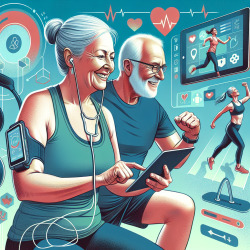The journey to recovery after a stroke can be challenging, especially when it comes to regaining physical fitness. Traditional rehabilitation programs often face barriers such as transportation issues and limited access to specialized facilities. However, recent research has introduced a promising alternative: telehealth-supervised exercise programs aimed at increasing cardiorespiratory fitness for stroke survivors.
The Feasibility of Telehealth Exercise Programs
A study published in the International Journal of Telerehabilitation assessed the feasibility and satisfaction levels of a home-based telehealth-supervised aerobic exercise program for individuals post-stroke. The results were overwhelmingly positive, with 95% of participants expressing enjoyment and willingness to recommend the program to others.
The telehealth program was structured over eight weeks, with participants engaging in moderate-to-vigorous intensity exercises three times per week. The study found that 85% of sessions were successfully conducted via telehealth, showcasing the reliability and effectiveness of this delivery method.
Benefits of Telehealth Exercise for Stroke Survivors
- Increased Accessibility: By eliminating the need for transportation, telehealth programs make it easier for stroke survivors to participate in regular exercise.
- Improved Cardiorespiratory Fitness: Participants experienced significant improvements in their cardiorespiratory fitness levels, which is crucial for reducing the risk of secondary strokes.
- User Satisfaction: The majority of participants found the telehealth platform easy to use and appreciated the convenience of exercising from home.
Implementing Telehealth Exercise Programs
If you're a practitioner looking to enhance your skills or offer more accessible rehabilitation options, consider integrating telehealth-supervised exercise programs into your practice. Here are some steps to get started:
- Assess Technological Requirements: Ensure that both you and your patients have access to reliable internet connections and suitable devices.
- Create Structured Programs: Design exercise routines that cater to varying levels of ability and focus on improving cardiorespiratory fitness.
- Provide Training and Support: Offer guidance on using telehealth platforms and ensure participants feel confident in managing their sessions independently.
- Elicit Feedback: Regularly collect feedback from participants to refine and improve the program's effectiveness and user experience.
The Future of Stroke Rehabilitation
The success of this telehealth exercise program highlights its potential as a viable alternative or supplement to traditional rehabilitation methods. As technology continues to advance, practitioners have an opportunity to explore new ways of delivering care that are both effective and accessible.
If you're interested in learning more about this groundbreaking approach, consider conducting further research or collaborating with experts in the field. By staying informed and adaptable, you can play a vital role in shaping the future of stroke rehabilitation.










